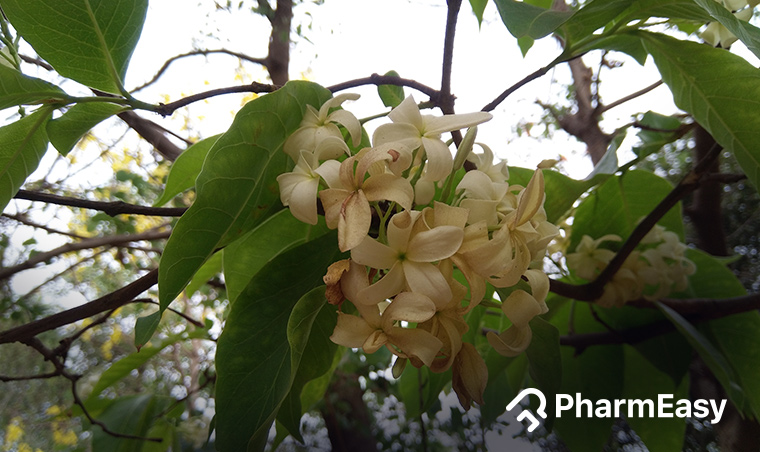Kutaja Benefits, Side Effects, Precautions & more!
By Dr Anuja Bodhare +2 more

Get,

to manage your symptom
Get your,


4 Cr+ families
benefitted

OTP sent to 9988776655



You’ve successfully subscribed to receive
doctor-approved tips on
Whatsapp

Get ready to feel your best.

Hi There,



Register to Avail the Offer
Send OTPBy continuing, you agree with our Privacy Policy and Terms and Conditions

Hi There,

Trusted by 4 crore+ families

OTP sent to 9988776655



You have unlocked 25% off on medicines




Code: NU25

By Dr Anuja Bodhare +2 more
Table of Contents
The shrub Holarrhena antidysenterica Linn (Family Apocynaceae), also known as ‘Indrajav’, ‘Coneru’ in English, and ‘Kutaja’ in Sanskrit, is found throughout India up to a height of 4,000 feet.
In India, especially in the Himalayan ranges, the plant is prolific. In India, Kutaja has traditional and folklore values. For example, people in the Indian state of Odisha offer this plant’s leaves together with rice during the ‘Nabanna’ celebration.

The plant can be found in Asia and Africa’s tropical and subtropical climates. The tree blooms in May-July in Burma, Sri Lanka, Pakistan, Nepal, and Africa. It can be found all over India, particularly in the deciduous forests of the tropical Himalayas, ranging from altitudes 900 to 1250 meters.1
The main components of Kutaja are steroidal alkaloids, resin, flavonoids, phenolic acids, triterpenoids, tannin, coumarins, saponins, and ergosterol. Conessine, kurchine, holarrhimine, conkurchine, holarrhenine, kurchicine, and conkurchinine are among the alkaloids found in the bark.1,2,3
The therapeutic uses of Kutaja are as follows:
In traditional Ayurvedic medicine, the stem bark, also known as ‘kurchi’ in India and ‘conessi bark’ in Europe, is used to cure dysentery, particularly amoebic dysentery.
Due to its strong potential to aid a wide range of illnesses, including amoebic dysentery, diarrhoea, asthma, skin conditions, and many other illnesses, Kutaja is a plant with significant commercial potential. Kutaja has well known anti-inflammatory benefits as well.
Dr. Siddharth Gupta, MD
Kutaja seeds have anti-amnesic properties because they lower acetylcholine levels and prevent the rise of glutathione and other elements that cause amnesia (deficit in memory caused by trauma, disease, or brain damage).1
In patients with bleeding piles, the stem bark extract of H. antidysenterica in ‘Kutajatvak churna’ exhibited therapeutic action.2
Kutaja has the strongest antibacterial action against Staphylococcus. However, the action is slightly less against Salmonella and E. coli.1
Also Read: Shallaki – Uses, Benefits, Side Effects & Precautions
In my experience, gout and other skin conditions may potentially be managed using Kutaja. Kutaja has blood purifying nature as well which makes it a potential aid for gout and skin diseases.
Dr. Rajeev Singh, BAMS
Kutaja is used in different forms like:
Your physician will prescribe you the appropriate dosage based on your individual needs.
Laghulai Churna is a significant polyherbal preparation which contains a wide variety of medicinal herbs. Its major component is Kutaja. In my experience, it may be helpful to aid in malnutrition syndrome (grahani), diarrhoea (atisara), discomfort (sula), and abdominal distension brought on by obstruction of the urine and faeces passages (anaha).
Dr. Smita barode, BAMS
Some of the side effects observed when consuming Kutaja are:
Also Read: Pippali – Uses, Benefits & Side Effects
Kutaja is known to possess anti-diabetic activity. Hence, Kutaja should be used with caution in diabetic patients on anti-diabetic drugs.
Kutaja may interact with anti-diabetic drugs and cause hypoglycaemia.1
Also Read: Citronella – Uses, Benefits, Side Effects & Precautions
Some of the common names of Kutaja are Bitter Oleander, Tellicherry Bark, Connessi Bark, Dysentery Rose Bay, and Kurchi Bark.4
Kutaja has long been used to manage diarrhoea, dysentery, and has anti-inflammatory, antioxidant, and anti-malarial effects. However, as technology advanced, other pharmacological qualities of the plants, such as anti-amnesic and neuroprotective capabilities, were discovered through experimental tests.1
No, Kutaja has no use for skin replenishment or skin rejuvenation properties.
The seeds and the bark can be used in the form of a powder. The leaves can be consumed as a whole.1
Kutajarishta, Kutajavleha, Kutajghan Vati, Mahamanjishtadi Kashayam, Stanyashodhana Kashaya, and Patoladi Choornam are some of the Ayurvedic compositions that contain this plant as a component. Pravahika (amoebiasis), Atisara (diarrhoea), Jwaratisara (secondary diarrhoea), Asra (blood or blood-related illnesses), Kustha (skin disorder), and Trsna (thirst) are some of the conditions it has traditionally been used to manage. The Brihat Bhaishajya Ratnakar mentions Bhunimbadi churna as a set of nine medicines that can be used to manage fever, jaundice, anaemia, and diabetes.3
Also Read: Vidarikand – Uses, Benefits & Precautions
Also Read: Majuphal – Uses, Benefits & Side Effects
Disclaimer:
The information provided here is for educational/awareness purposes only and is not intended to be a substitute for medical treatment by a healthcare professional and should not be relied upon to diagnose or treat any medical condition. The reader should consult a registered medical practitioner to determine the appropriateness of the information and before consuming any medication. PharmEasy does not provide any guarantee or warranty (express or implied) regarding the accuracy, adequacy, completeness, legality, reliability or usefulness of the information; and disclaims any liability arising thereof.
Links and product recommendations in the information provided here are advertisements of third-party products available on the website. PharmEasy does not make any representation on the accuracy or suitability of such products/services. Advertisements do not influence the editorial decisions or content. The information in this blog is subject to change without notice. The authors and administrators reserve the right to modify, add, or remove content without notification. It is your responsibility to review this disclaimer regularly for any changes.

Leave your comment...
Comments